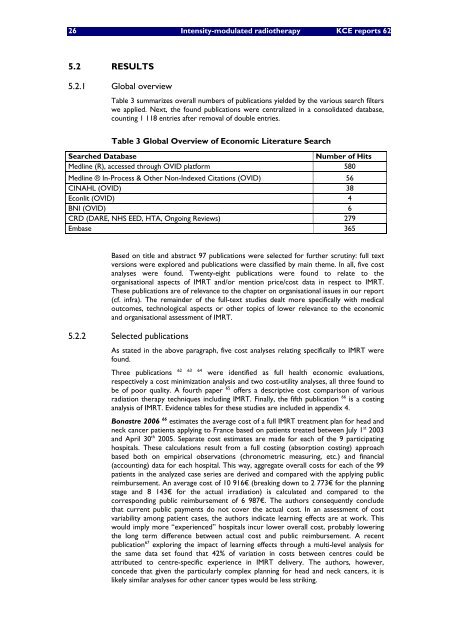Intensiteitsgemoduleerde Radiotherapie (IMRT) - KCE
Intensiteitsgemoduleerde Radiotherapie (IMRT) - KCE
Intensiteitsgemoduleerde Radiotherapie (IMRT) - KCE
Create successful ePaper yourself
Turn your PDF publications into a flip-book with our unique Google optimized e-Paper software.
26 Intensity-modulated radiotherapy <strong>KCE</strong> reports 62<br />
5.2 RESULTS<br />
5.2.1 Global overview<br />
Table 3 summarizes overall numbers of publications yielded by the various search filters<br />
we applied. Next, the found publications were centralized in a consolidated database,<br />
counting 1 118 entries after removal of double entries.<br />
Table 3 Global Overview of Economic Literature Search<br />
Searched Database Number of Hits<br />
Medline (R), accessed through OVID platform 580<br />
Medline ® In-Process & Other Non-Indexed Citations (OVID) 56<br />
CINAHL (OVID) 38<br />
Econlit (OVID) 4<br />
BNI (OVID) 6<br />
CRD (DARE, NHS EED, HTA, Ongoing Reviews) 279<br />
Embase 365<br />
Based on title and abstract 97 publications were selected for further scrutiny: full text<br />
versions were explored and publications were classified by main theme. In all, five cost<br />
analyses were found. Twenty-eight publications were found to relate to the<br />
organisational aspects of <strong>IMRT</strong> and/or mention price/cost data in respect to <strong>IMRT</strong>.<br />
These publications are of relevance to the chapter on organisational issues in our report<br />
(cf. infra). The remainder of the full-text studies dealt more specifically with medical<br />
outcomes, technological aspects or other topics of lower relevance to the economic<br />
and organisational assessment of <strong>IMRT</strong>.<br />
5.2.2 Selected publications<br />
As stated in the above paragraph, five cost analyses relating specifically to <strong>IMRT</strong> were<br />
found.<br />
Three publications 62 63 64 were identified as full health economic evaluations,<br />
respectively a cost minimization analysis and two cost-utility analyses, all three found to<br />
be of poor quality. A fourth paper 65 offers a descriptive cost comparison of various<br />
radiation therapy techniques including <strong>IMRT</strong>. Finally, the fifth publication 66 is a costing<br />
analysis of <strong>IMRT</strong>. Evidence tables for these studies are included in appendix 4.<br />
Bonastre 2006 66 estimates the average cost of a full <strong>IMRT</strong> treatment plan for head and<br />
neck cancer patients applying to France based on patients treated between July 1 st 2003<br />
and April 30 th 2005. Separate cost estimates are made for each of the 9 participating<br />
hospitals. These calculations result from a full costing (absorption costing) approach<br />
based both on empirical observations (chronometric measuring, etc.) and financial<br />
(accounting) data for each hospital. This way, aggregate overall costs for each of the 99<br />
patients in the analyzed case series are derived and compared with the applying public<br />
reimbursement. An average cost of 10 916€ (breaking down to 2 773€ for the planning<br />
stage and 8 143€ for the actual irradiation) is calculated and compared to the<br />
corresponding public reimbursement of 6 987€. The authors consequently conclude<br />
that current public payments do not cover the actual cost. In an assessment of cost<br />
variability among patient cases, the authors indicate learning effects are at work. This<br />
would imply more “experienced” hospitals incur lower overall cost, probably lowering<br />
the long term difference between actual cost and public reimbursement. A recent<br />
publication 67 exploring the impact of learning effects through a multi-level analysis for<br />
the same data set found that 42% of variation in costs between centres could be<br />
attributed to centre-specific experience in <strong>IMRT</strong> delivery. The authors, however,<br />
concede that given the particularly complex planning for head and neck cancers, it is<br />
likely similar analyses for other cancer types would be less striking.

















